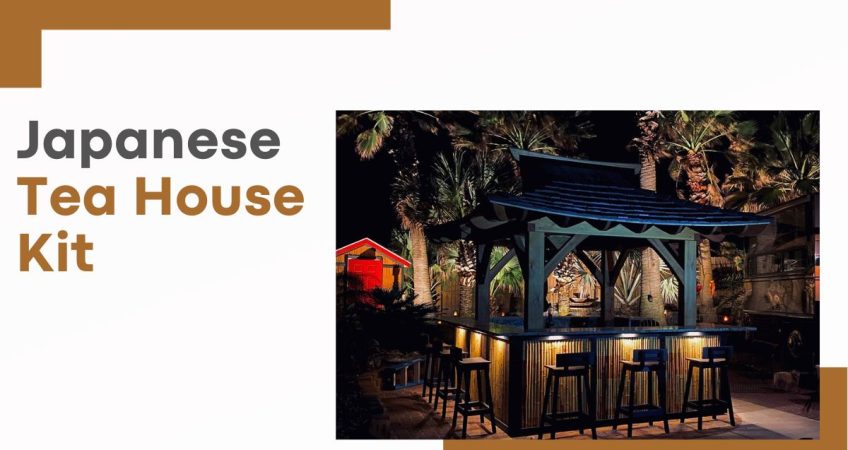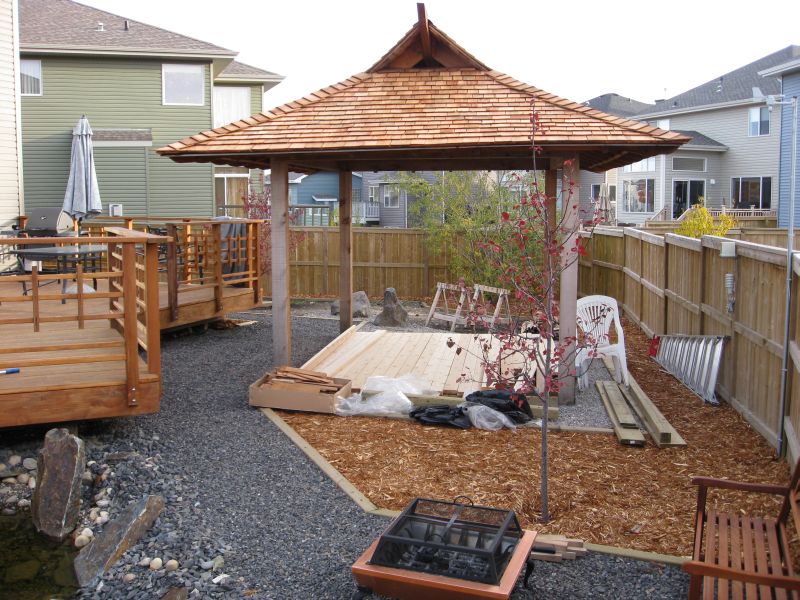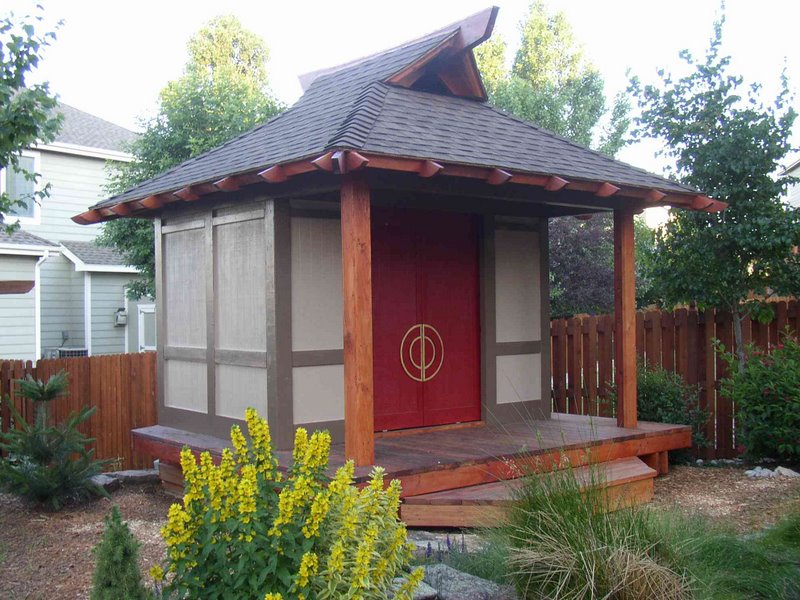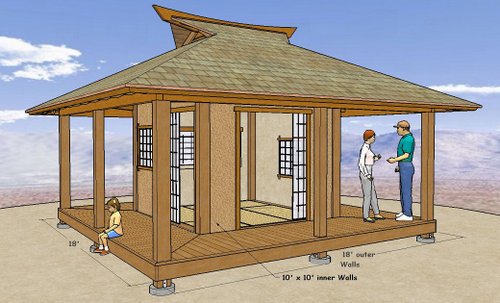Build Your Own Japanese Tea House Kit for Authentic Serenity

Immerse yourself in a realm of calmness and tranquility right in your backyard by crafting your very own Japanese Tea House. A cornerstone of Zen culture, these serene structures are a testament to the charm of simplicity and peace. Create an authentic retreat that not only enhances the beauty of your surroundings but also offers a window into the enchanting world of traditional Japanese tea ceremonies. Witness how this small, yet profound addition to your home can transform your reality, offering moments of respite and serenity in our fast-paced world. Isn’t it exciting to consider the possibility of building your own sanctuary of peace? Let’s embark on this exciting journey together!
Unveiling the Japanese Tea House Kit Concept
The Japanese Tea House Kit is a magnificent blend of history, culture, and tranquility, designed to facilitate ease of construction while maintaining authenticity. This kit contains everything necessary to embark on the rewarding journey of crafting your personal oasis of calm. It includes pre-cut materials, a comprehensive guide for assembly, and a detailed rundown of the traditional elements that make a tea house a pivotal part of Japanese culture.
This concept is more than just a DIY project; it is an invitation to immerse in the captivating world of Zen traditions while fostering craftsmanship and creativity. Building your own Japanese Tea House isn’t simply about beautifying your backyard, but also about embracing an age-old culture and its timeless philosophy of simplicity and tranquility. It’s a path towards creating an authentic space for meditation and reflection, right in the comfort of your home.
Understanding the Components of the Japanese Tea House Kit
Our DIY Japanese Tea House Kits are designed to make the construction process smooth and simple. They come with everything you need to create your unique Zen space, from detailed instructions and high-quality materials, right down to the last screw.

The allure of creating a self-constructed space lies in the sense of personal accomplishment and the unique customization that DIY kits offer. You have the freedom to make your tea house truly your own, from the color of the wood to the choice of window placements.
The authenticity of the Japanese tea house you construct is assured, as our kits are designed with traditional Japanese architectural principles in mind. The final product is not just functional, but also a work of art that serves as a fitting tribute to the centuries-old tradition of Japanese tea ceremonies.
The Allure of DIY: Building Your Tea House from the Ground Up
There’s a profound satisfaction that comes with the creation of your own space, especially one as serene and culturally rich as a Japanese Tea House. The DIY route provides an opportunity to be involved in each step of the construction process, from choosing where each panel goes, to the triumphant moment of adding the final touches. This hands-on approach not only infuses an intimate personal connection into your tea house, but it also allows for a sense of accomplishment that pre-built structures often lack.
The freedom to personalize is another remarkable aspect of these DIY kits. While following the traditional architectural principles, you are unrestricted in customizing your tea house to match your personal taste and needs. Whether you want a unique window placement to capture the best garden view, or you have a specific color palette in mind to complement your outdoor décor, this flexibility permits you to craft a Japanese Tea House that is truly a reflection of your aesthetic and vision. This balance between the traditional parameters and personal customization is what makes the experience of building your own Japanese Tea House an authentic, yet deeply personal journey.
Read More: Architectural Elegance: Unveiling Japanese Tea House Plans
Step-by-Step Guide: Assembling Your Japanese Tea House Kit
Assembling your own Japanese Tea House may seem like a daunting task at first. But, our easy-to-follow guide, coupled with the all-in-one DIY kit, ensures a hassle-free and enjoyable journey of crafting your tranquil haven. This step-by-step guide will walk you through the process of assembly, offering clear instructions and helpful tips to aid you in construction. With a little patience and the spirit of a craftsman, you will soon be able to unveil a beautiful Japanese Tea House, hand-built by you, in your backyard.

Construction Process with Clear Instructions
The construction process of our Japanese Tea House Kit is as straightforward as it is enjoyable. The kit comes with a detailed step-by-step guide that breaks down each stage of the building process, from preparing the base to attaching the final shoji screen. Each step is explained in simple, clear language, accompanied by diagrams for visual reference. We believe that the building process should be a meditative experience in itself, not a source of stress or confusion.
Importance of Precision and Attention to Detail
A Japanese tea house is a testament to the beauty of precision and attention to detail. These elements are woven into the fabric of the Zen philosophy, with each component of the tea house serving a symbolic purpose. The kit encourages you to embrace this mindfulness, guiding you through the exact placement of each piece and highlighting the significance of each element. Whether it’s aligning the tatami mats or positioning the tokonoma, every step in the construction process is a nod to the traditional Japanese aesthetic. This meticulous attention to detail ensures that your tea house is not only a stunning structure but also a serene space that embodies the Zen philosophy.
Incorporating Traditional Japanese Design Principles
Our DIY Japanese Tea House Kit is thoughtfully designed to align with traditional Japanese design principles. Key elements such as Shoji Screens, Tatami Mats, and various roofing styles are incorporated to ensure an authentic experience.
Shoji Screens are a quintessential aspect of Japanese architecture, characterized by their translucent paper panels that allow for natural light to filter in, creating a serene, warm ambiance. These screens are more than just partitions; they stand as a symbol of the Japanese ethos of harmony with nature.
Tatami Mats are another traditional feature included in the kit. Historically, these mats were used for seating in Japanese homes, but in a tea house, they serve a more aesthetic purpose. Their unique texture and color add an authentic feel to the tea house. Meanwhile, their uniform size aids in the structured layout of the space.
In terms of roofing, our kits offer a variety of options inspired by traditional Japanese styles. Whether you prefer the curved elegance of the ‘Irimoya’ style or the simplistic charm of the ‘Kirizuma’ style, you can choose a roof that best complements your personal taste while staying true to traditional aesthetics.
Despite the adherence to traditional design, our kits also encourage personalization. While the core elements maintain their traditional essence, there’s ample room to incorporate your personal style. This balance between tradition and individuality ensures that each Japanese Tea House you construct is an authentic representation of Japanese culture, but also a unique reflection of your personal aesthetic.
Read More: How to Build a Gazebo Roof
Creating an Inviting Atmosphere Inside Your Tea House
Creating an inviting atmosphere inside your tea house is as essential as its exterior design. There are several elements that you can incorporate to enhance the serenity and tranquility of the space.
Chigaidana (Alcove Shelves) and Tokonoma (Art Display Area) are traditional elements of a Japanese Tea House that also serve practical purposes. The Chigaidana, or staggered shelves, are an excellent platform for displaying tea utensils or ikebana arrangements. The Tokonoma, on the other hand, is a recessed area typically showcasing a hanging scroll and a flower arrangement, subtly reflecting the season or theme of the tea gathering.
Lighting plays a crucial role in setting up the mood. Natural light filtered through Shoji Screens can create a warm and inviting ambiance. Meanwhile, traditional lanterns or modern, minimalist light fixtures can be used to enhance the soft glow in the evenings.
Lastly, the choice of decor can greatly influence the atmosphere. Incorporating elements such as a bamboo water feature, Zen garden view, or simply, the sound of rustling leaves can add a touch of nature, enhancing the serenity of your tea house. Remember, the goal is to create a space that fosters mindfulness and relaxation, so choose your decor elements carefully to achieve that serene ambiance.
Maintenance Tips for Long-Lasting Serenity
Preserving the beauty of your Japanese Tea House requires regular care and attention. Just as the construction process revels in mindfulness and precision, maintaining your tea house should also reflect these principles. Regular cleaning is essential, whether it’s dusting the tatami mats or wiping down the shoji screens. It’s important to use gentle, non-abrasive cleaning solutions to avoid damaging the materials.

Wood, being a primary component of your tea house, needs particular attention. Protecting the wood not only contributes to the overall aesthetics but also extends the longevity of your tea house. Use a high-quality wood sealant to guard against weather damage and to maintain the wood’s natural color. This should be done annually, or more frequently depending on your local climate.
Also, pay attention to the roof. Regardless of the style you’ve chosen, it’s crucial to check for any signs of damage or wear and tear regularly. This will allow you to intervene promptly if any repair or replacement is needed.
And lastly, the interior elements such as tokonoma and chigaidana also require care. Keep them dust-free and rotate their displays regularly in sync with the seasons or the theme of your tea gathering.
Remember, the Japanese Tea House is more than a structure; it’s a space for mindfulness and tranquility. Every step in its maintenance should echo these principles, thus ensuring the longevity of your serene haven.
Conclusion
In conclusion, building an authentic Japanese Tea House is not merely a construction project, but an immersive journey into a rich cultural heritage. From the assembly of traditional elements such as Shoji Screens and Tatami Mats, to the careful selection of decor, every step is a mindful exploration of the Japanese aesthetic. The result is a serene haven that does not just stand as a beautiful structure in your garden but serves as a space for tranquility where you can escape the hustle and bustle of daily life. We hope that this guide instills a sense of confidence and creativity in you to embark on this DIY adventure. At Wood’s Shop, we are always here to aid you in your quest for lasting serenity. Remember to prioritize maintenance as much as design, for this ensures that your tea house continues to be a symbol of peace and mindfulness for years to come. Happy building!
Frequently Asked Questions
1. Can I customize the elements of the Tea House kit?
Yes, our Tea House kits are designed with an emphasis on both tradition and personalization. While the core elements maintain their traditional essence, there’s ample room for you to incorporate your personal style.
2. How often should I maintain the wood components of my Tea House?
Wood, as a primary component of your tea house, should be treated annually with a high-quality wood sealant to guard against weather damage and maintain its natural color. However, this frequency may vary depending on your local climate.
3. What decor elements can I incorporate to enhance the serenity of my Tea House?
Elements such as a bamboo water feature, Zen garden view, or the sound of rustling leaves can add a touch of nature to your Tea House. The key is to create a space that fosters mindfulness and relaxation, so choose your decor elements carefully to achieve that serene ambiance.